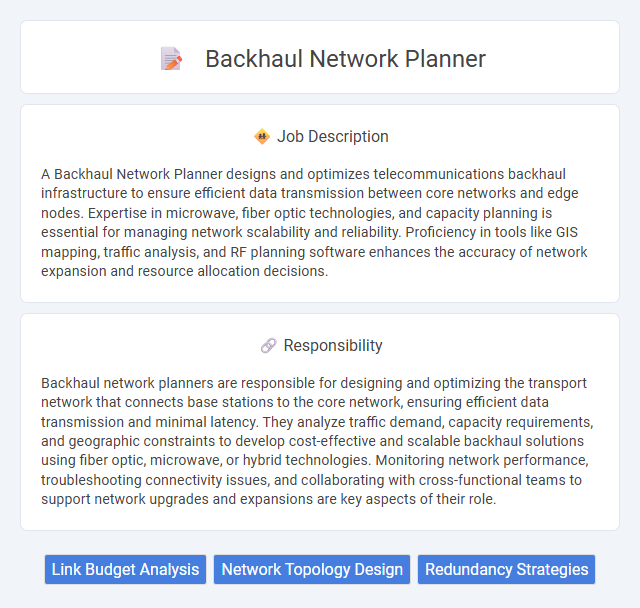
A Backhaul Network Planner designs and optimizes telecommunications backhaul infrastructure to ensure efficient data transmission between core networks and edge nodes. Expertise in microwave, fiber optic technologies, and capacity planning is essential for managing network scalability and reliability. Proficiency in tools like GIS mapping, traffic analysis, and RF planning software enhances the accuracy of network expansion and resource allocation decisions.
Individuals with strong analytical skills and a detail-oriented mindset are likely suitable for a Backhaul Network Planner role, as the job requires precise network design and optimization. Candidates who can handle complex data and collaborate with technical teams may perform better in this position. People who prefer routine tasks or have difficulty adapting to evolving technology might find this job less compatible with their strengths.
Qualification
A Backhaul Network Planner must possess a strong background in telecommunications engineering, with expertise in RF planning, microwave link design, and fiber optic networks. Proficiency in GIS mapping tools, network simulation software, and an understanding of 5G network architecture are essential for optimizing backhaul routes. Advanced analytical skills, attention to detail, and experience with network capacity planning ensure efficient and scalable network infrastructure deployment.
Responsibility
Backhaul network planners are responsible for designing and optimizing the transport network that connects base stations to the core network, ensuring efficient data transmission and minimal latency. They analyze traffic demand, capacity requirements, and geographic constraints to develop cost-effective and scalable backhaul solutions using fiber optic, microwave, or hybrid technologies. Monitoring network performance, troubleshooting connectivity issues, and collaborating with cross-functional teams to support network upgrades and expansions are key aspects of their role.
Benefit
A Backhaul network planner likely enhances operational efficiency by optimizing data transmission routes, which may reduce latency and improve overall network reliability. This role could provide substantial cost savings through strategic resource allocation and infrastructure planning. Professionals in this position often gain valuable experience in network architecture, boosting their career growth potential in telecommunications.
Challenge
Backhaul network planners likely face the challenge of optimizing capacity and coverage while managing cost constraints and evolving technology standards. They must navigate complex data traffic patterns and anticipate future network demands to prevent bottlenecks. Handling coordination between multiple vendors and ensuring seamless integration might also present ongoing difficulties.
Career Advancement
Backhaul network planners design and optimize the infrastructure connecting core networks to edge nodes, ensuring high-capacity and low-latency data transmission. Mastery in fiber optic technology, microwave links, and network topology analysis enables career growth into senior planning roles or network architecture leadership. Advancing expertise in 5G backhaul solutions and automated network management tools significantly enhances professional prospects and salary potential.
Key Terms
Link Budget Analysis
Backhaul network planners specialize in designing and optimizing microwave and fiber optic links to ensure seamless connectivity between core and access networks. Link Budget Analysis is a critical task that calculates the total gain and loss for a communication link, factoring in parameters such as transmit power, antenna gains, path loss, fading margin, and system noise figure to guarantee reliable signal strength over distance. Accurate Link Budget Analysis directly impacts network capacity, coverage, and quality of service in 4G, 5G, and emerging wireless infrastructures.
Network Topology Design
Backhaul network planners specialize in designing efficient network topologies that connect core networks to access points, ensuring optimal data transmission. They analyze traffic patterns and geographic constraints to develop resilient, scalable backhaul architectures using technologies such as fiber optics, microwave links, and millimeter wave systems. Their expertise in topology design enhances network performance, reduces latency, and supports growing bandwidth demands in telecommunications infrastructure.
Redundancy Strategies
Backhaul network planners design and implement redundancy strategies to ensure continuous connectivity and minimize service disruption in telecommunications infrastructure. They analyze traffic patterns and potential failure points to create multiple data paths using diverse routes and technologies like fiber optics, microwave links, and satellite systems. Effective redundancy planning enhances network reliability, optimizes resource allocation, and supports seamless data transmission across the backhaul network.
 kuljobs.com
kuljobs.com